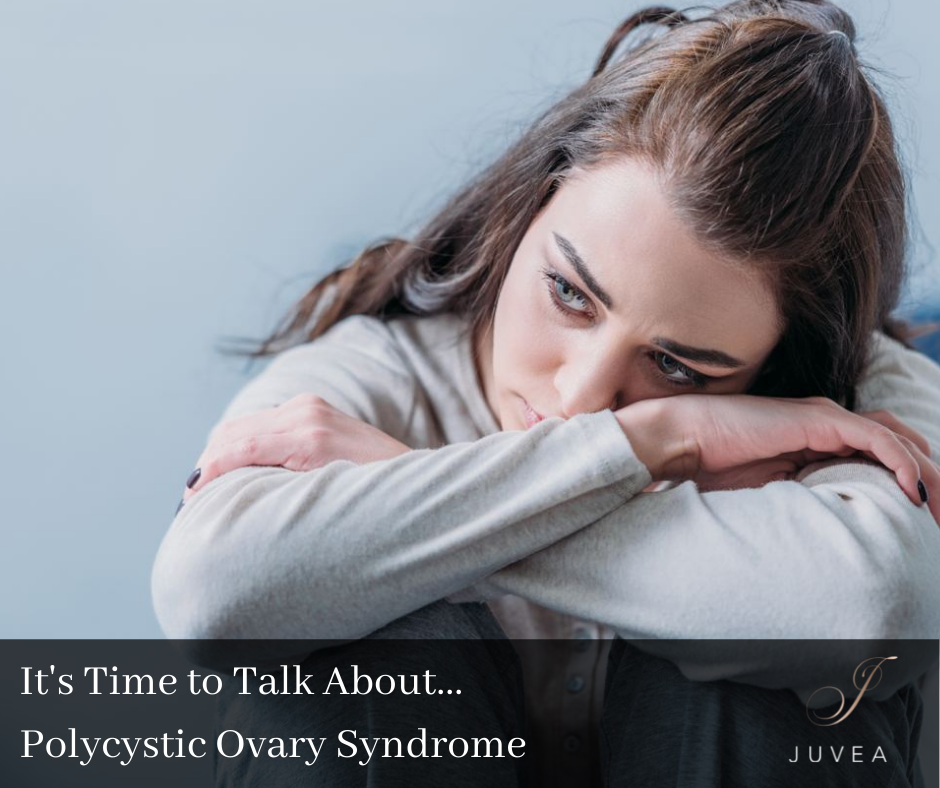29.06.21

Polycystic Ovary Syndrome (PCOS) is the most common female hormonal disorder, affecting around 4-18% of reproductive-age women and AFAB individuals worldwide. Despite this, PCOS remains an underdiagnosed condition, with many women seeing three or more doctors over more than two years before receiving a PCOS diagnosis, even though the syndrome can put women at a higher risk of Type II Diabetes, infertility, and even cancer of the womb.
At Juvea Aesthetics, we believe that this can only be changed through education, so we’ve put together an introduction to Polycystic Ovary Syndrome, its symptoms, treatment options and available support networks.
What is Polycystic Ovary Syndrome?
Although the exact cause of PCOS is unknown, we do know that it is related to abnormal hormone levels in the body, including high levels of insulin (a hormone which controls sugar levels in the body). According to the NHS, many women with PCOS are resistant to the action of insulin in their body and so produce higher levels of insulin to compensate. These higher insulin levels contribute to an increase in the production and activity of hormones like testosterone. Women with PCOS are also found to have lower levels of sex hormone-binding globulin, a protein which reduces the effects of testosterone. These hormonal abnormalities together with symptoms like missing periods and ovaries with a polycystic appearance can be diagnosed as PCOS.
How is Polycystic Ovarian Syndrome diagnosed?
Polycystic Ovarian Syndromeother rare causes
- You have irregular or infrequent periods (this indicates that your ovaries do not regularly release an egg.
- You have had blood tests that show higher levels of male hormones (also known as androgens) such as testosterone.
- You have polycystic ovaries (as you can see, despite the name you do not have to have polycystic ovaries to have PCOS).
In the UK, if you’re diagnosed with PCOS, you may continue to be treated by your GP, or you may be referred to a gynaecologist or endocrinologist for further treatment and discussion around how best to manage the condition.
Symptoms of Polycystic Ovary Syndrome
Polycystic Ovary Syndromerange
- Irregular, infrequent or no periods at all
- Irregular ovulation, or no ovulation at all
- Reduced fertility and increased risk of miscarriage
- Excess, unwanted facial or body hair (hirsuitism), often in male-like patterns
- Thinning hair or male-pattern hair loss from the scalp (alopecia)
- Oily skin and acne
- Weight problems including rapid weight gain and difficulty losing weight
- Depression and mood swings
Not all individuals will experience the same symptoms or the same severity of symptoms, which can range from mild to severe.
Treatment Options for Polycystic Ovary Syndrome
Polycystic Ovary Syndromelifestyle changes
Lifestyle changes
Well, as much as we want to roll our eyes, it turns out that being overweight actually does worsen the symptoms of PCOS. With that in mind, try to make healthy changes to your lifestyle; whether that’s moving more, or eating a healthier diet with plenty of fruit and veg, complex carbs, and lean protein.
Medication
Progestogen tabletsother hormonal methods
Aesthetic Treatment
Excess facial hair growth can be one of the more demoralising aspects of PCOS, particularly if you find your skin is too sensitive for daily or twice daily shaving, or regular waxing. Laser hair removal is an alternative to traditional hair removal methods which uses heat to damage the hair follicle. Although this treatment isn’t completely pain free, it hurts less than waxing or tweezing. You will need 6 – 8 monthly treatments to see full results, however these results should last for years (or even be permanent). We offer Laser Hair Removal for the upper lip, jawline, chin, chest, back and buttocks at Juvea Aesthetics – just get in touch for a free consultation and see if this treatment could help you get some confidence back.
Treating Fertility Problems
Polycystic Ovary Syndrome is the leading cause of fertility problems in women, but with treatment, you should find that you are able to get pregnant. Clomifene is normally the first line treatment for women with PCOS struggling to conceive, as it encourages monthly ovulation. If this is unsuccessful, then Metformin may be used as it can lower insulin and blood sugar levels in women with PCOS. If tablets are not effective, you may then be offered a course of injections or IVF treatment.
Remember, You’re Not Alone
When you’re first diagnosed with PCOS, or when you’re experiencing symptoms like excess hair growth, male pattern hair loss, or even fertility issues; it can be incredibly easy to feel like you’re alone in all this. We’re here to tell you that you’re not.
Although PCOS may be underdiagnosed, it affects at least one in ten women worldwide; and many of these women have come together to form local, national, and even international support groups. Check out the links below for resources and support as you get a handle on your PCOS symptoms.
Local Groups – Verity – The UK PCOS Charity – England and Wales
Verity PCOS Scotland
Verity PCOS Northern Ireland
Soul Cysters – Women with PCOS Speak From the Heart – Global Support
PCOS Challenge – Global Support






































